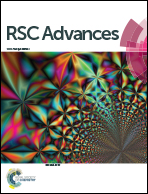Kirkendall void formation and selective directional growth of urchin-like ZnO/Zn microspheres through thermal oxidation in air†
Abstract
Microparticles with nanostructures on the surface have the characteristics of nanomaterials, yet they avoid aggregation and dispersion problems due to the nature of the nanomaterials. We report a simple, cost-effective, catalyst-free, and scalable production of urchin-like ZnO/Zn microspheres through thermal oxidation from Zn microparticles at 350–550 °C in air for a period of 6–36 hours. The novel, urchin-like microspheres are composed of (from inner to outer): a hollow core, a thin-shell of Zn, a thick-shell of ZnO and ZnO nanowires grown radially on the surface with a tip diameter of 20 nm, with a high aspect ratio (length/diameter), and a high population density. In our study, the Kirkendall effect was proposed for the formation of the hollow core/void of the urchin-like microspheres. Selective directional growth of ZnO nanowires with (100) orientation, followed by interdiffusion and propagation of oxygen and zinc for the lengthening the ZnO nanowires, were proposed for the formation mechanism of the ZnO nanowires. Studies on the field emission properties of the microspheres show that the microspheric emitter has a low turn-on field of 2.2 V μm−1, a high field enhancement factor of 6804.8, a high luminance of 24 000 cd m−2, and excellent luminance uniformity.


 Please wait while we load your content...
Please wait while we load your content...